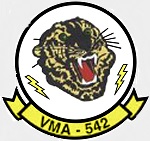Hobby Master HA2621 USMC Boeing Harrier II AV-8B Jump Jet - VMA-542 "Tigers", Marine Corps Air Station Cherry Point, North Carolina, 2016 [Low-Vis Scheme] (1:72 Scale)
"Obsolete weapons do not deter."
- British Prime Minister Margaret Thatcher
 The AV-8B Harrier II is a second generation vertical short takeoff and landing (V/STOL) aircraft based on the original British Harrier design of the late 1960's. Combining tactical mobility, responsiveness, reduced operating cost, and basing flexibility -- both afloat and ashore -- V/STOL aircraft are well-suited to the special combat and expeditionary requirements of the US Marine Corps.
The AV-8B Harrier II is a second generation vertical short takeoff and landing (V/STOL) aircraft based on the original British Harrier design of the late 1960's. Combining tactical mobility, responsiveness, reduced operating cost, and basing flexibility -- both afloat and ashore -- V/STOL aircraft are well-suited to the special combat and expeditionary requirements of the US Marine Corps.
The primary mission of the AV-8B Harrier II is to provide close air support to ground forces. Secondary missions include short range interdiction, fighter escort, deck launched interception, and combat air patrol (CAP).
After completing operational evaluation trials in March 1985, the USMC AV-8B Harrier II was formally approved for full production some six months later. A two-seat training version was introduced in 1987 and a night attack version entered service in late 1989.
Pictured here is a 1:72 scale USMC Harrier AV-8B jump jet that was attached to VMA-542 "Tigers", then deployed to Marine Corps Air Station Cherry Point, North Carolina, during 2016.
Sold Out!
Dimensions:
Wingspan: 5-inches
Length: 7-3/4-inches
Release Date: June 2018
 Historical Account: "Tigers" - In August 1990, the Tigers deployed to the Bahrain in support of Operation Desert Shield. After three months at that location, the squadron deployed to King Abdul Aziz Naval Base, Jubail, Saudi Arabia, as part of the most forward deployed fixed wing group in theater.
Historical Account: "Tigers" - In August 1990, the Tigers deployed to the Bahrain in support of Operation Desert Shield. After three months at that location, the squadron deployed to King Abdul Aziz Naval Base, Jubail, Saudi Arabia, as part of the most forward deployed fixed wing group in theater.
Within twelve hours of arrival in Bahrain, Tiger pilots were standing 24-hour combat alerts. The alert status lasted until five hours after the commencement of Operation Desert Storm on January 17th, 1991 when the first division of VMA-542 Harriers launched to suppress Iraqi artillery positions in Southern Kuwait. From that day forward. Tiger "Harriers" flew a sustained combat sortie rate until the end of hostilities on February 27th, 1991.
On February 22nd, two days prior to the initiation of the ground offensive, the Tigers of VMA-542 surged to a schedule of 58 sorties per day as the final battlefield preparation was initiated. These final prep fires included Mk77 Napalm delivered on trench lines in the area where the Marine Expeditionary Force breaching operation would occur. In addition, the Tigers continued targeting of enemy artillery and armor, which could be brought to bear against the Allies during their breaching operations.
Throughout these forty-two days of conflict the Tigers of VMA-542 flew more than 1000 combat sorties amassing over 1200 flight hours while delivering over one thousand tons of ordnance on the enemy. When the war commenced, VMA-542 responded by delivering more ordnance, flying more sorties, and accruing more combat hours than any other V/STOL squadron in theater.
The Tigers returned to MCAS Cherry Point in April 1991. Shortly thereafter the squadron was selected to introduce the new Radar/Night Attack AV-8B Harrier II Plus to the fleet in 1993.
On August 8th, 1997, the squadron deployed 12 aircraft to Marine Corps Air Station Yuma. The deployment training got off to a strong start but was daunted by the loss of one of the jets piloted by Capt Samuel H. Smith. After several days of flight suspension, the word came that time consuming inspections would have to be conducted on the aircraft before they could be flown again. These inspections revealed internal engine damage in four of twelve of the aircraft, requiring complete engine replacement.
September marked a recovery period as the squadron deployed two jets and approximately 25 Marines back to Yuma Arizona to support the fall Weapons and Tactics Instructor (WTI) course.
The squadron's detachment aboard USS Kearsarge (LHD-3) returned to Cherry Point on October 12th, 1997, after being deployed for nearly six months. A Capabilities Exercise (CAPEX) was conducted on October 7th-10th, and just as the operational tempo hit top gear, the squadron experienced yet another setback on October 16th, when one of the jets was lost in Dayton, Ohio.
May 1999 marked the return of the 24th Marine Expeditionary Unit boat detachment from combat operations in Kosovo. Their support of NATO operations was the first in armed conflict since Desert Storm. They successfully flew 38 combat sorties deployed aboard the USS Nassau (LHA-4).






![Star Trek Klingon Goroth's Transport [With Collector Magazine]](http://cdn4.volusion.store/qh9e9-jdqv9/v/vspfiles/photos/EMST0071-1.jpg?v-cache=1740197136)
